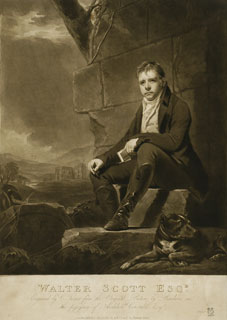
Charles Turner (1773–1857) after Henry Raeburn (1756–1823)
Walter Scott Esq.
1810
Mezzotint, published state
The composer Felix Mendelssohn and the painter J.M.W. Turner were both enthusiastic readers of the doyen of Romantic novelists, Sir Walter Scott. Scott had initially won international fame for such poems as the Lady of the Lake, and it was as perhaps the most popular poet of the day that Raeburn portrayed him in 1810. In 1814, Scott turned to the novel, with the publication of Waverly, but published all his novels anonymously for reasons that remain unclear.
Raeburn’s portrait was commissioned in 1808 by Archibald Constable, Scott’s publisher, in recognition of the success of the narrative poem Marmion. It exemplifies Romantic portraiture, suggesting the linkage between the poet and the landscape in which he lived, and which inspired him. The hills of Liddesdale and Hermitage Castle, seen behind him, feature in Marmion. Despite a pronounced limp, Scott was a keen outdoorsman, as the portrait suggests, and walked miles with his beloved bull terrier, Camp. Raeburn’s portrait was widely reproduced in various media, but the rich, deep tonality of the mezzotint process produced the most effective translation of this memorable image.
Scott’s poem The Lord of the Isles contains a powerful stanza alluding to Fingal’s Cave, although it focused on the cave’s geological, even theological, significance rather than its connection with Ossianic legend. Both Turner and Mendelssohn knew these lines, and their response to the cave was partly inspired by them.
YALE CENTER FOR BRITISH ART, PAUL MELLON COLLECTION
B1970.3.612
